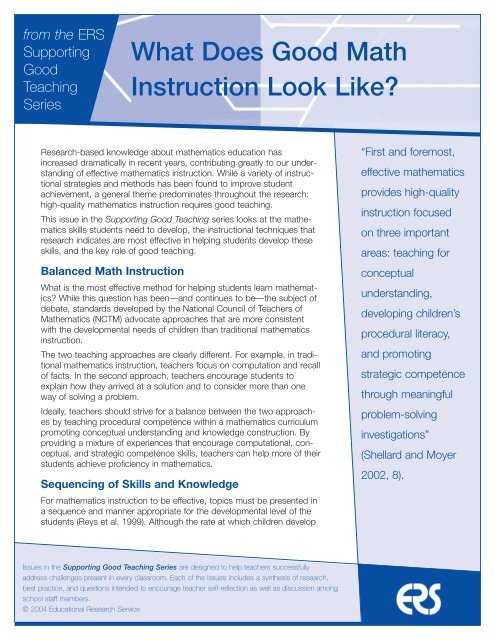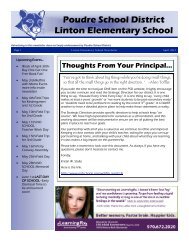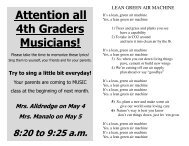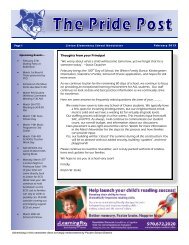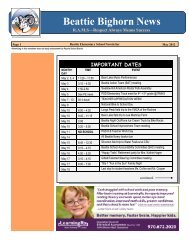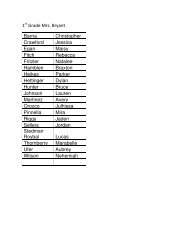What Does Good Math Instruction Look Like? - PSD
What Does Good Math Instruction Look Like? - PSD
What Does Good Math Instruction Look Like? - PSD
Create successful ePaper yourself
Turn your PDF publications into a flip-book with our unique Google optimized e-Paper software.
from the ERS<br />
Supporting<br />
<strong>Good</strong><br />
Teaching<br />
Series<br />
<strong>What</strong> <strong>Does</strong> <strong>Good</strong> <strong>Math</strong><br />
<strong>Instruction</strong> <strong>Look</strong> <strong>Like</strong><br />
Research-based knowledge about mathematics education has<br />
increased dramatically in recent years, contributing greatly to our understanding<br />
of effective mathematics instruction. While a variety of instructional<br />
strategies and methods has been found to improve student<br />
achievement, a general theme predominates throughout the research:<br />
high-quality mathematics instruction requires good teaching.<br />
This issue in the Supporting <strong>Good</strong> Teaching series looks at the mathematics<br />
skills students need to develop, the instructional techniques that<br />
research indicates are most effective in helping students develop these<br />
skills, and the key role of good teaching.<br />
Balanced <strong>Math</strong> <strong>Instruction</strong><br />
<strong>What</strong> is the most effective method for helping students learn mathematics<br />
While this question has been—and continues to be—the subject of<br />
debate, standards developed by the National Council of Teachers of<br />
<strong>Math</strong>ematics (NCTM) advocate approaches that are more consistent<br />
with the developmental needs of children than traditional mathematics<br />
instruction.<br />
The two teaching approaches are clearly different. For example, in traditional<br />
mathematics instruction, teachers focus on computation and recall<br />
of facts. In the second approach, teachers encourage students to<br />
explain how they arrived at a solution and to consider more than one<br />
way of solving a problem.<br />
Ideally, teachers should strive for a balance between the two approaches<br />
by teaching procedural competence within a mathematics curriculum<br />
promoting conceptual understanding and knowledge construction. By<br />
providing a mixture of experiences that encourage computational, conceptual,<br />
and strategic competence skills, teachers can help more of their<br />
students achieve proficiency in mathematics.<br />
Sequencing of Skills and Knowledge<br />
For mathematics instruction to be effective, topics must be presented in<br />
a sequence and manner appropriate for the developmental level of the<br />
students (Reys et al. 1999). Although the rate at which children develop<br />
“First and foremost,<br />
effective mathematics<br />
provides high-quality<br />
instruction focused<br />
on three important<br />
areas: teaching for<br />
conceptual<br />
understanding,<br />
developing children’s<br />
procedural literacy,<br />
and promoting<br />
strategic competence<br />
through meaningful<br />
problem-solving<br />
investigations”<br />
(Shellard and Moyer<br />
2002, 8).<br />
Issues in the Supporting <strong>Good</strong> Teaching Series are designed to help teachers successfully<br />
address challenges present in every classroom. Each of the issues includes a synthesis of research,<br />
best practice, and questions intended to encourage teacher self-reflection as well as discussion among<br />
school staff members.<br />
© 2004 Educational Research Service
2<br />
Using Research and Best Practice to Support <strong>Good</strong> Teaching<br />
“Research suggests it is not necessary<br />
for teachers to focus first on<br />
skill development and then move<br />
on to problem solving. Both can be<br />
done together. Skills can be developed<br />
on an as-needed basis, or<br />
their development can be supplemented<br />
through the use of technology.<br />
In fact, there is evidence that if<br />
students are initially drilled too<br />
much on isolated skills, they have a<br />
harder time making sense of them<br />
later” (Grouws 2004, 168).<br />
between such processes as addition and multiplication,<br />
and subtraction and division. <strong>Instruction</strong> should<br />
introduce multiplicative reasoning, equivalence, and a<br />
variety of methods for computation. <strong>Instruction</strong> at this<br />
level also should focus on developing children’s interest<br />
in mathematics.<br />
• Middle school students in grades six through eight<br />
are forming conclusions about their mathematical<br />
abilities, interest, and motivation that will influence<br />
how they approach mathematics in later years.<br />
<strong>Instruction</strong> at this level should build on their emerging<br />
capabilities to think hypothetically, comprehend cause<br />
and effect, and reason in both concrete and abstract<br />
terms. Algebra and geometry form a large part of the<br />
recommended curriculum during these years.<br />
• At the high school level, students should be “adept at<br />
visualizing, describing, and analyzing situations in<br />
mathematical terms … they need to be able to justify<br />
and prove mathematically based ideas” (2001,<br />
online). Oftentimes, it is helpful for students at this<br />
developmental level to supplement their fundamental<br />
mathematics knowledge with additional courses,<br />
such as computer science or statistics.<br />
An important key to developmentally appropriate mathematics<br />
instruction, at any age or grade level, is achieving<br />
balance between teaching for conceptual understanding<br />
and teaching for procedural fluency. When<br />
students learn procedures without meaning, they are<br />
really only memorizing discrete pieces of information<br />
that are much more difficult for them to remember.<br />
Students should develop an understanding of the conmathematically<br />
varies from child to child, the NCTM<br />
(2001) has developed a general timeline for students’<br />
mathematical skills development and instruction identified<br />
as appropriate for each level. According to this<br />
timeline:<br />
• From pre-kindergarten through second grade, children<br />
are developing a mathematical foundation by<br />
building beliefs about what mathematics is and what<br />
it means to know and do mathematics. <strong>Instruction</strong><br />
should be provided that helps them understand patterns<br />
and measurement and develop a solid understanding<br />
of the numeration system.<br />
• Building on the inquisitive nature of children in grades<br />
three through five, students should be encouraged to<br />
develop and investigate solutions to everyday problems.<br />
<strong>Instruction</strong> should focus on the relationship<br />
Basic Components of <strong>Math</strong>ematical Literacy<br />
1. Problem solving. Students must learn to solve problems by applying previously learned or<br />
acquired knowledge to new situations.<br />
2. Communicating mathematical ideas. Students need to learn the language and notation used<br />
in mathematics. They should be able to communicate mathematical ideas through the use of<br />
manipulatives, drawings, writing, and speaking.<br />
3. Applying mathematics to everyday situations. Students should be able to translate daily<br />
experiences into mathematical representations, such as graphs, tables, and diagrams, and interpret<br />
and explain the results.<br />
4. Focusing on appropriate computational skills. Students must gain proficiency in using the<br />
following mathematical operations: addition, subtraction, multiplication, and division, as well as<br />
with using whole numbers, fractions, and decimals (Mercer and Miller n.d.).
<strong>What</strong> <strong>Does</strong> <strong>Good</strong> <strong>Math</strong> <strong>Instruction</strong> <strong>Look</strong> <strong>Like</strong> 3<br />
cepts they are studying before they apply these ideas<br />
to procedural strategies.<br />
To determine readiness, teachers can pose questions<br />
to assess student levels of understanding at different<br />
points during the lesson, before students are asked to<br />
apply skills. <strong>Good</strong> mathematics instruction will ensure<br />
students “see” mathematics as a body of connected<br />
ideas building on one another.<br />
“The student should be the<br />
reference point for addressing the<br />
complex issue of who should learn<br />
what mathematics and when”<br />
(Sutton and Krueger 2002, 4).<br />
Providing <strong>Instruction</strong> for a Range of<br />
Knowledge and Skill Levels<br />
While the research on grouping and tracking for mathematics<br />
instruction is mixed, some studies suggest:<br />
Expectations placed on students differ according<br />
to their assigned ability group or track . . .<br />
[and there are] crucial differences in the kinds of<br />
instruction offered…. <strong>Instruction</strong> in the lower<br />
tracks tends to be fragmented, often requiring<br />
mostly memorization of basic facts and algorithms<br />
and the filling out of worksheets.<br />
Although some higher track classes share these<br />
traits, they are more likely to offer opportunities<br />
for making sense of mathematics, including discussion,<br />
writing, and applying mathematics to<br />
real life situations (Sutton and Krueger 2002, 4).<br />
An alternative, especially in the elementary and middle<br />
grades, is a differentiated approach to instruction. Using<br />
this approach, the teacher makes intensive use of information<br />
gathered through formal and informal assessment—much<br />
of which is embedded in instruction—to<br />
decide which skills and knowledge individual students<br />
need at a specific point in time to help them move<br />
toward competence in a particular standard. Although<br />
ability grouping is used in addition to whole-class instruction,<br />
the groups are fluid and membership changes<br />
often, depending on the specific instruction needed to<br />
move specific students to higher levels of learning.<br />
Effective <strong>Math</strong>ematical Environments<br />
Teachers should work toward improving the effectiveness<br />
of their mathematics instruction by creating classroom<br />
environments that support students’ developing<br />
mathematical skills and nurture their interest in mathematics.<br />
Both teacher behaviors and instructional characteristics<br />
are important.<br />
Teacher Behaviors<br />
In effective classrooms, teachers project a positive attitude<br />
about mathematics, use questioning techniques to<br />
facilitate learning, and encourage students to develop<br />
divergent solutions and inventive ideas for presentation<br />
to and discussion with the whole group.<br />
Acceptance of Students’ Divergent Ideas<br />
Throughout a lesson, the teacher should accept varied<br />
responses from students, challenge them to think more<br />
deeply about the problems they are solving, and ask<br />
them to explain the solutions. An accepting and<br />
encouraging atmosphere is essential so students do<br />
not develop mathematics anxiety. It is important that<br />
teachers’ comments and questions help students<br />
develop confidence in their own abilities to do mathematics.<br />
In addition, discussion helps the student explain<br />
his or her approach to gain an even firmer grasp of the<br />
concept and provides other students with alternative<br />
ways to solve a specific problem.<br />
Teacher Questioning<br />
Teachers can influence learning by posing challenging<br />
and interesting questions. Comments and questions for<br />
students should demonstrate a sound understanding of<br />
the mathematics behind the lesson. Rather than tell<br />
students the answers, teachers should present questions<br />
that stimulate students’ curiosity and encourage<br />
them to investigate further. Teachers may give students<br />
suggestions and hints, and ask additional questions<br />
that lead them to search for different solutions. The<br />
questions should encourage students to rely on one<br />
another and themselves for ideas about mathematics<br />
and problem solving.<br />
Teacher Attitudes<br />
Student motivation and success in mathematics are<br />
greatly influenced by teacher attitude, which should communicate—through<br />
speech and actions—what material is<br />
important and how to learn it. To create an environment<br />
that supports mathematical learning, teachers must communicate<br />
to students that mathematics is an important
4<br />
Using Research and Best Practice to Support <strong>Good</strong> Teaching<br />
activity in which their efforts are valued. A teacher’s attitude<br />
toward mathematics should demonstrate enthusiasm<br />
for the content and a belief that all students are<br />
capable of learning the material, with lessons designed to<br />
encourage curiosity and interest as well as skill building.<br />
<strong>Instruction</strong>al Characteristics<br />
In addition to teacher behaviors, certain instructional<br />
characteristics also are associated with effective mathematics<br />
instruction. By embedding the following<br />
approaches in instruction, teachers can promote student<br />
learning and motivation:<br />
• Students are actively engaged in doing mathematics.<br />
• Students are solving challenging problems.<br />
• Interdisciplinary connections and examples are used<br />
to teach mathematics.<br />
• Students are sharing their mathematical ideas while<br />
working in pairs and groups.<br />
• Students are provided with a variety of opportunities<br />
to communicate mathematically.<br />
• Students are using manipulatives, calculators, and<br />
computers.<br />
Being Actively Engaged in Doing <strong>Math</strong>ematics<br />
Students should not be sitting back watching others<br />
“do mathematics”; rather, everyone should be engaged<br />
in the investigations. This encouragement might take<br />
the form of working on an interesting problem, using<br />
manipulatives to find several solutions to a problem, or<br />
using a computer graphing program to represent mathematical<br />
data. <strong>What</strong> is important is that all students are<br />
involved in finding the solutions.<br />
Solving Challenging Problems<br />
<strong>Math</strong>ematics is a stimulating and interesting field generating<br />
new knowledge every day, and students should<br />
be exposed to this excitement and challenge. Problems<br />
that involve various steps or that model mathematics<br />
problem solving in the real world are more authentic and<br />
meaningful for students. Students should be provided<br />
with opportunities to practice using many different skills<br />
embedded in solving an interesting problem.<br />
Use of Small Groups in <strong>Math</strong>ematics <strong>Instruction</strong><br />
Research findings clearly support the use of small groups as part of mathematics instruction. This<br />
approach can result in increased student learning as measured by traditional achievement measures as<br />
well as other important outcomes, such as improvement in student ability to communicate, resolve differences,<br />
and get along with others. When using small groups for mathematics instruction, teachers should:<br />
• Choose tasks dealing with important mathematical concepts and ideas.<br />
• Select tasks appropriate for group work.<br />
• Consider having students initially work individually on a task and then engage in group work to share<br />
and build on their individual ideas and work.<br />
• Give clear instructions to the groups, and set clear expectations for each group.<br />
• Emphasize both group goals and individual accountability—for example, indicate that an individual<br />
from each group will report for the group, but withhold his or her name until group work has been<br />
completed.<br />
• Choose tasks students find interesting.<br />
• Ensure the group work has closure, where key ideas and methods are brought to the surface either<br />
by the teacher, the students, or both.<br />
Finally, as several research studies have shown, teachers should not think of small groups as an approach<br />
that must always be used or never be used. Rather, small-group instruction should be seen as an appropriate<br />
instructional practice for certain learning objectives, and as an approach that can work well with<br />
other organizational arrangements, including whole-class instruction (adapted from Grouws 2004).
<strong>What</strong> <strong>Does</strong> <strong>Good</strong> <strong>Math</strong> <strong>Instruction</strong> <strong>Look</strong> <strong>Like</strong> 5<br />
In addition, students should be asked to do more than<br />
the application of mathematical procedures. Research<br />
that compares the way in which mathematics is typically<br />
taught in many U.S. classrooms with the approach<br />
used in other countries with higher mathematics<br />
achievement suggests U.S. students should be provided<br />
with more opportunities to “make connections.” For<br />
example, “in asking students to solve for x in the equation<br />
2x+3=11, teachers might also have asked if it<br />
would be acceptable to divide each side by a specific<br />
number, changing the process from a simple use of<br />
procedure to a more complex examination” of the<br />
problem (Association for Supervision and Curriculum<br />
Development 2003, online).<br />
Using Interdisciplinary Connections and Examples<br />
Using literature as a springboard to mathematical investigation<br />
is a useful way to introduce a problem in context<br />
and encourage meaningful mathematics investigations.<br />
A mathematics investigation placed in the context<br />
of a story provides an authentic problem-solving situation,<br />
sometimes with “messy” results that model realworld<br />
problems. This engages students in connecting<br />
the language of mathematical ideas with numerical representations<br />
and develops important skills that support<br />
students’ abilities to solve word problems. Teachers<br />
may also connect mathematics with other content<br />
areas in the school curriculum, such as science, social<br />
studies, or language arts, to show its relevance to<br />
problem solving in different disciplines.<br />
Providing Opportunities for Group Work<br />
Research shows students who work in groups on<br />
problems, assignments, and other mathematical investigations<br />
display increased achievement. Opportunities<br />
for students to work in pairs and small groups give<br />
them the chance to share their ideas and solution<br />
routes with peers. As students listen to and talk with<br />
one another, they begin to see mathematical relationships<br />
that build on their previous notions and conjectures.<br />
Giving an explanation to a peer is also positively<br />
related to increased student achievement.<br />
Allowing Opportunities for Student Communication<br />
During a lesson, students should have many opportunities<br />
to communicate their ideas. They may draw their<br />
ideas in pictures or write them in mathematics journals.<br />
After students work on a challenging problem, the<br />
teacher should ask individuals or groups to share their<br />
solution routes by presenting them on chart paper or a<br />
transparency. Whole-class discussions, which are effective<br />
for sharing and explaining solutions, give students a<br />
chance to challenge and evaluate the validity of other<br />
students’ ideas in an environment of respect and<br />
understanding.<br />
Using Manipulatives<br />
The long-term use of mathematics manipulatives is<br />
positively related to student achievement and attitudes<br />
about mathematics. It is not enough, however, to simply<br />
provide students with manipulatives: they must be<br />
taught how to use these materials. When used correctly,<br />
manipulatives are “conducive to the concrete kinds<br />
of learning that lay a sufficient foundation for abstract<br />
thought” (Ross and Kurtz 1993, 256).<br />
Several steps can be taken to ensure students benefit<br />
from a lesson involving manipulatives. First, the teacher<br />
must make certain the manipulatives support the lesson’s<br />
objectives. Second, before allowing students to<br />
handle the materials, the teacher must demonstrate use<br />
of the manipulatives and procedures for handling them.<br />
And third, the lesson design must support the active<br />
participation of all students (Ross and Kurtz 1993).<br />
Teachers should provide students with a wide variety of<br />
manipulative materials for use in mathematics activities.<br />
Students should use manipulatives to represent mathematics<br />
in concrete form, and then proceed to using pictorial<br />
models and abstract symbols. There should be<br />
items for drawing and writing about mathematics during<br />
problem solving, as well as geometric shapes and other<br />
materials for building and exploring.<br />
Using Calculators and Technology<br />
Another important tool for the mathematics classroom<br />
is technology. As with manipulatives, the way a teacher<br />
uses technological tools determines the tools’ effectiveness<br />
for conveying mathematical ideas. The computer<br />
environment provides many visual representations—<br />
graphs, diagrams, geometric figures, and moving<br />
images. The sheer graphic power of technological tools<br />
allows students to explore and manipulate many different<br />
visual representations of mathematical models.<br />
Virtual manipulatives are now available for investigating<br />
the characteristics of geometric shapes (Moyer,<br />
Bolyard, and Spikell 2002). A child as young as kindergarten<br />
age can explore complex repeating patterns<br />
using virtual manipulatives on the computer screen.<br />
Because technology use is one key to language and<br />
mathematical literacy, students need different opportunities<br />
to learn to use it effectively as a learning tool.
6<br />
Using Research and Best Practice to Support <strong>Good</strong> Teaching<br />
National Council of Supervisors of <strong>Math</strong>ematics: Components of Essential <strong>Math</strong>ematics<br />
1. Problem Solving. Learning to solve problems is the principal reason for studying mathematics. Problem solving<br />
is the process of applying previously acquired knowledge to new and unfamiliar situations. Solving word problems<br />
in texts is one form of problem solving, but students also should be faced with non-text problems.<br />
2. Communicating <strong>Math</strong>ematical Ideas. Students should learn the language and notation of mathematics. For<br />
example, they should understand place value and scientific notation. They should learn to receive mathematical<br />
ideas through listening, reading, and visualizing. They should be able to present mathematical ideas by speaking,<br />
writing, drawing pictures and graphs, and demonstrating with concrete models. They should be able to discuss<br />
and ask questions about mathematics.<br />
3. <strong>Math</strong>ematical Reasoning. Students should learn to make independent investigations of mathematical ideas.<br />
They should be able to identify and extend patterns and use experiences and observations to make conjectures<br />
(tentative conclusions). They should be able to distinguish between valid and invalid arguments.<br />
4. Applying <strong>Math</strong>ematics to Everyday Situations. Students should be encouraged to translate everyday situations<br />
into mathematical representations (graphs, tables, diagrams, or mathematical expressions), process the<br />
mathematics, and interpret the results in light of the initial situation. They should be able to solve ratio, proportion,<br />
percent, direct variation, and inverse variation problems. Students should see how mathematics is applied in the<br />
real world, as well as observe how mathematics grows from the world around them.<br />
5. Alertness to the Reasonableness of Results. In solving problems, students should question the reasonableness<br />
of a solution or conjecture in relation to the original problem. Students must develop number sense to determine<br />
if results of calculations are reasonable in relation to the original numbers and the operations used. With<br />
society’s increasing use of calculating devices, this capability is more important than ever.<br />
6. Estimation. Students should be able to carry out rapid approximate calculations by using mental arithmetic and<br />
various computational estimation techniques. Students should acquire simple methods for estimating measurements<br />
such as length, area, volume, and mass (weight). They should be able to decide when a particular result is<br />
precise enough for the purpose at hand.<br />
7. Appropriate Computational Skills. Students should gain facility in using addition, subtraction, multiplication,<br />
and division with whole numbers and decimals. In learning to apply computation, students should have practice in<br />
choosing the appropriate computational method: mental arithmetic, paper-pencil algorithm, or calculating device.<br />
8. Algebraic Thinking. Students should learn to use variables (letters) to represent mathematical quantities and<br />
expressions, and they should be able to represent mathematical functions and relationships using tables, graphs,<br />
and equations. They should understand and correctly use positive and negative numbers, order of operations, formulas,<br />
equations, and inequalities. They should recognize the ways in which one quantity changes in relation to<br />
another.<br />
9. Measurement. Students should learn the fundamental concepts of measurement through concrete experiences.<br />
They should be able to measure distance, mass (weight), time, capacity, temperature, and angles. They should<br />
learn to calculate simple perimeters, areas, and volumes. They should be able to perform measurement in both<br />
metric and customary systems using the appropriate tools and levels of precision.<br />
10. Geometry. Students should understand the geometric concepts necessary to function effectively in the threedimensional<br />
world. They should have knowledge of concepts such as parallelism, perpendicularity, congruence,<br />
similarity, and symmetry. Students should know properties of simple plane and solid geometric figures.<br />
11. Statistics. Students should plan and carry out the collection and organization of data to answer questions in their<br />
everyday lives. Students should know how to construct, read, and draw conclusions from simple tables, maps,<br />
charts, and graphs. They should be able to present information about numerical data such as measure of central<br />
tendency (mean, median, mode) and measures of dispersion (range, deviation). Students should recognize the<br />
basic uses and misuses of statistical representation and inference.<br />
12. Probability. Students should understand elementary notions of probability to determine the likelihood of future<br />
events. They should become familiar with how mathematics is used to help predict election results, business forecasts,<br />
and outcomes of sporting events. They should learn how probability applies to research results and to the<br />
decision-making process (excerpted from National Council of Supervisors of <strong>Math</strong>ematics 1989, 44-46).
<strong>What</strong> <strong>Does</strong> <strong>Good</strong> <strong>Math</strong> <strong>Instruction</strong> <strong>Look</strong> <strong>Like</strong> 7<br />
Calculator use in early-grades mathematics instruction<br />
has caused great debate within the mathematics community<br />
and among the general public (Battista 1994;<br />
Calvert 1999; Goldenberg 2000; Mercer 1992).<br />
Calculator use can affect not only how students learn but<br />
also what they learn. As with other mathematics tools, it<br />
is how the tool is used for teaching and learning—not<br />
the tool itself—that causes the debate. Advocates for<br />
calculator use in the early grades propose students use<br />
calculators in school mathematics to explore patterns<br />
and relationships with numbers. For example, young children<br />
can examine patterns among very large numbers<br />
with the support of a calculator or create a graph of a<br />
large data set using graphing programs.<br />
This does not mean that students should use calculators<br />
when they are working to develop computational<br />
fluency. During problem solving or when working with<br />
large numbers, however, calculators can be used to<br />
relieve the burden of complex computations and to<br />
help students focus on the concepts being presented.<br />
Opportunities to use calculators as part of the curriculum<br />
throughout the year help students to recognize<br />
when calculator use is appropriate.<br />
<strong>Good</strong> Teaching Is Key<br />
Of course, effective mathematics instruction begins<br />
with effective teaching. No lesson, no matter how well<br />
planned, can be successful if the elements of effective<br />
teaching are not in place. Douglas Grouws, editor of<br />
the Handbook of Research on <strong>Math</strong>ematics Teaching<br />
and Learning and author of the mathematics chapter in<br />
Handbook of Research on Improving Student<br />
Achievement, discusses instructional practices identified<br />
by research as having a positive impact on student<br />
learning and then mentions the role of the teacher:<br />
The quality of the implementation of a teaching<br />
practice also greatly influences its impact on<br />
student learning. The value of using manipulative<br />
materials to investigate a concept, for<br />
example, depends not only on whether manipulatives<br />
are used, but also on how they are used<br />
with the students. Similarly, small-group instruction<br />
will benefit students only if the teacher<br />
knows when and how to use this teaching<br />
practice (2004, 162).<br />
Finally, effective teachers of mathematics must be<br />
effective teachers overall, exhibiting effective classroom<br />
management skills, especially in classrooms using differentiated<br />
instruction; actively engaging their students;<br />
and making efficient use of instructional time. A mathematics<br />
lesson cannot succeed if the other elements of<br />
teaching—classroom management, a logical progression<br />
of lessons, an effective use of assessment, and<br />
time management—are not in place.<br />
References<br />
Association for Supervision and Curriculum Development. (2003,<br />
October). International comparisons of mathematics instruction.<br />
Research Brief. Retrieved from<br />
http://www.ascd.org/publications/researchbrief/volume1/v1n21.html<br />
Battista, M.T. (1994). Calculators and computers: Tools for mathematical<br />
exploration and empowerment. Arithmetic Teacher (March<br />
1994), 412-417.<br />
Calvert, L.G. (1999). A dependence on technology and algorithms<br />
or a lack of number sense Teaching Children <strong>Math</strong>ematics<br />
(September 1999), 6-7.<br />
Goldenberg, E.P. (2000). Thinking (and talking) about technology in<br />
mathematics classrooms. Newton, MA: The K-12 <strong>Math</strong>ematics<br />
Curriculum Center, Education Development Center, Inc. Retrieved<br />
from http://www2.edc.org/mcc/iss_tech.pdf<br />
Grouws, D.A. (2004). Chapter 7. <strong>Math</strong>ematics. In G. Cawelti (Ed.),<br />
Handbook of Research on Improving Student Achievement (3rd edition),<br />
162-181. Arlington, VA: Educational Research Service.<br />
Mercer, J. (1992). <strong>What</strong> is left to teach if students can use calculators<br />
The <strong>Math</strong>ematics Teacher (September 1992), 415-417.<br />
Mercer, C.D., & Miller, S.P. (n.d.). Teaching students with learning<br />
problems in math to acquire, understand, and apply basic facts.<br />
Retrieved from<br />
http://www.enc.org/print/professional/learn/equity/articles/document.shtminput=ACQ-111397-1397_1<br />
Moyer, P.S., Bolyard, J.J., & Spikell, M.A. (2002). <strong>What</strong> are virtual<br />
manipulatives Teaching Children <strong>Math</strong>ematics (February 2002),<br />
372-377.<br />
National Council of Supervisors of <strong>Math</strong>ematics. (1989). Essential<br />
mathematics for the 21st century. Arithmetic Teacher (September<br />
1989), 44-46.<br />
National Council of Teachers of <strong>Math</strong>ematics (NCTM). (2001).<br />
Principals and standards for school mathematics. Retrieved from<br />
http://www.nctm.org/standards/overview.htm<br />
Reys, R.E., Suydam, M.N., Lindquist, M.M., & Smith, N.L. (1999).<br />
Helping children learn mathematics (5th edition). New York: John<br />
Wiley and Sons, Inc.<br />
Ross, R., & Kurtz, R. (1993). Making manipulatives work: A strategy<br />
for success. Arithmetic Teacher (January 1993), 254-257.<br />
Shellard, E., & Moyer, P.S. (2002). <strong>What</strong> principals need to know<br />
about teaching math. Alexandria, VA: National Association of<br />
Elementary School Principals and Educational Research Service.<br />
Sutton, J., & Krueger, A. (2002). EDThoughts: <strong>What</strong> we know about<br />
mathematics teaching and learning. Aurora, CO: Mid-continent<br />
Research for Education and Learning.
8<br />
<strong>What</strong> <strong>Does</strong> <strong>Good</strong> <strong>Math</strong> <strong>Instruction</strong> <strong>Look</strong> <strong>Like</strong><br />
Questions for Discussion and Reflection<br />
• How do you ensure your students truly understand the math concepts they are studying rather than<br />
merely memorizing procedures Share and discuss any specific techniques with your colleagues.<br />
• Revisit the section titled “Effective <strong>Math</strong>ematical Environments” and glance through the section subheadings.<br />
Are your personal teaching behaviors and instructional characteristics consistent with<br />
those recommended How might you improve the environment in your classroom<br />
• Discuss the information from the National Council of Supervisors of <strong>Math</strong>ematics provided in the<br />
text with your colleagues. Do you consider the components listed when developing lesson plans<br />
The following ERS Info-Files are related resources available from<br />
ERS. These resources provide an overview of research and information<br />
to give you a general understanding of a particular topic or<br />
concern in K-12 education. Each Info-File contains 70-100 pages<br />
of articles from professional journals, summaries of research<br />
studies and related literature, and an annotated bibliography<br />
that includes an ERIC-CIJE search. Base cost-recovery price<br />
per title: $40. Subscriber discounts are available.<br />
<strong>Math</strong> Manipulatives and Calculators (#NT-5180)<br />
Describes the use of concrete objects (manipulatives) to teach<br />
mathematical concepts. Includes suggestions for materials and<br />
use. Discusses the rationale for using calculators to teach mathematical<br />
concepts.<br />
Problem Solving in <strong>Math</strong> and Science (#NT-5292)<br />
Reviews effective methods and strategies for teaching problem<br />
solving in grades K-12. Materials include ideas for activities, as well<br />
as grading methods.<br />
Grouping for <strong>Math</strong> <strong>Instruction</strong> (#NT-5306)<br />
Assesses ability grouping in math instruction and the effects of<br />
tracking in math classes. Offers alternative grouping formats and<br />
presents guidelines for forming effective small groups to promote<br />
peer interaction and group problem solving.<br />
To order, contact ERS at the address below. Add the greater of<br />
$4.50 or 10 percent of the total price for postage and handling.<br />
Phone and online orders accepted with purchase order number<br />
or Visa, MasterCard, or American Express.<br />
Educational Research Service is the nonprofit research foundation<br />
that for 30 years has provided education leaders with objective,<br />
reliable K-12 research and information. Contact ERS to learn how<br />
you can benefit from the online and print services and resources<br />
available through an annual subscription. Or visit us online at<br />
www.ers.org for an overview of the wealth of K-12 resources<br />
available from ERS.<br />
Purchasers of the Supporting <strong>Good</strong> Teaching Series CD-ROM<br />
are granted permission to make print copies of each item for<br />
distribution to school and district staff. The content must be used<br />
in the format provided. The content cannot be excerpted for use<br />
in another publication or newsletter. In addition, the materials may<br />
not be resold or used as a handout for programs for which a fee<br />
is charged.<br />
ERS Supporting <strong>Good</strong> Teaching Staff:<br />
Jennifer Turner, Research Specialist<br />
Elizabeth Shellard, Senior Research Specialist<br />
Nancy Protheroe, Director of Special Research Projects<br />
Jeanne Chircop, Manager, Editorial Services<br />
ERS Management Staff:<br />
John M. Forsyth, Ph.D., President and Director of Research<br />
Katherine A. Behrens, Senior Director, Marketing and<br />
Member Services<br />
Patrick R. Murphy, Senior Director, Finance and Administration<br />
The ERS Board of Directors is composed of the executive directors<br />
of the seven national founding organizations:<br />
• American Association of School Administrators<br />
• American Association of School Personnel Administrators<br />
• Association of School Business Officials International<br />
• Council of Chief State School Officers<br />
• National Association of Elementary School Principals<br />
• National Association of Secondary School Principals<br />
• National School Public Relations Association<br />
Educational Research Service<br />
2000 Clarendon Boulevard • Arlington, VA 22201-2908<br />
Tel: (800) 791-9308 • Fax: (800) 791-9309<br />
Email: ers@ers.org • Web site: www.ers.org


